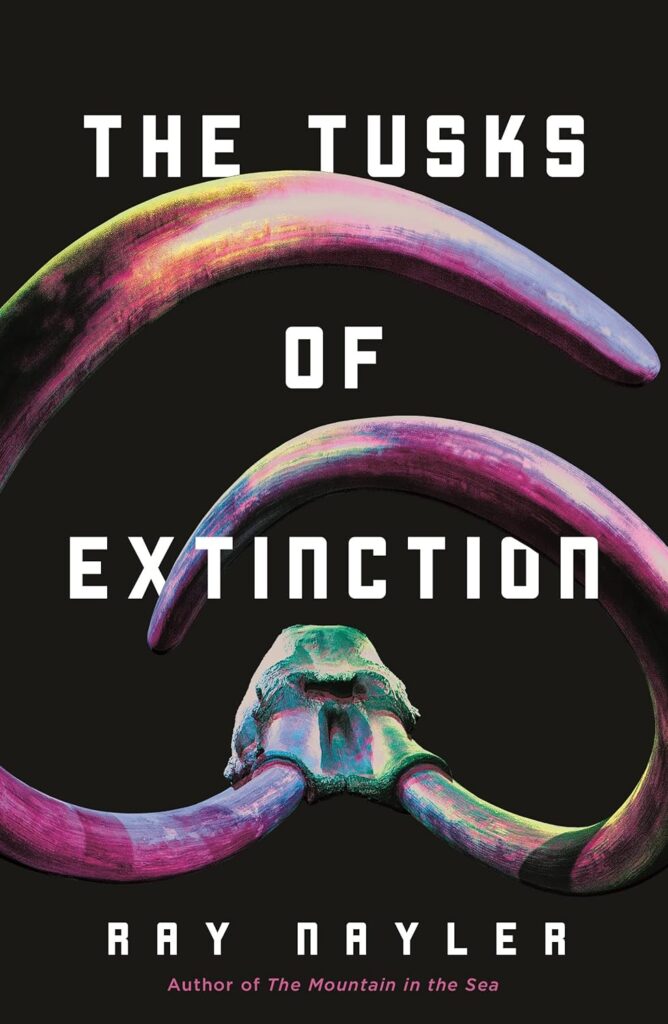Ray Nayler’s beautiful novella, The Tusks of Extinction, focuses on a handful of very different characters whose lives converge on a hunting expedition in the Russian taiga at least a century in the future. That convergence manages to speak volumes about human nature, greed, memory, family bonds, the connection of living things to the earth and the stakes of survival of great species. In just a few strokes for each character, Nayler creates a vivid sense of their rich inner lives, their longings and fantasies of how things might change. While a much briefer work than The Mountain in the Sea, this is a great follow-on to many of that novel’s ideas. (To describe what’s going on in this short book, I’ve necessarily included some spoilers, so be warned.)
We meet Damira in the opening chapter of The Tusks of Extinction and have to do a double-take. She seems to be the consciousness of a great woolly mammoth, a species brought back from extinction. But then we’re in the mind of a woman fighting poachers in Africa to protect the last free herds of elephants. We soon learn that these events take place over a century apart.
The human Damira became one of the great experts on the lives and habits of elephants as well as their fierce defender against poachers. She’s taken up weapons to fight alongside African game wardens against the cartels making huge sums off the ivory trade. After gaining great renown in her field, this Damira has her consciousness uploaded to a computer in Moscow. She is wakened a century later when Dr. Aslanov proposes transferring her consciousness to a mammoth. Though the species has been revived in captivity after decades of reconstructing their genome, when released to the wild the mammoths lack the instincts to survive. Aslanov believes Damira’s deep knowledge of elephants will help them adapt to their new circumstances within a vast refuge in the Siberian taiga.
Svyatoslav is the son of a poacher who was mostly absent from his childhood, “a rare thing in their home — sweeping in loud and chaotic … an anticipation, an encounter, a departure.” And in a paragraph or two we feel his attachment to his mother, even as she is dying. We also get his wonderful sense of the connections he wants to see among all things and that might draw him into a better life. He reluctantly accompanies his father and a drunken crew of poachers on a hunt for mammoths. These are hopeless men who will never get the riches they dream of, as the mammoth tusks they take from slaughtered giants will either be stolen or the money lost through reckless living.
Vladimir is a member of an authorized hunting party in the company of his husband, the wealthy Anthony, and Dr. Aslanov who created the refuge. They travel the roadless taiga in great rumbling wagons fitted out like luxury railroad cars of a bygone era. Aslanov needs to earn money to make the refuge self-sustaining and is willing to do this through sanctioned, luxury hunts of mammoth males. It is Vladimir whose conscience is most troubled by tracking down and killing the mammoths since he cannot believe his gentle husband has a cold killing streak in his nature.
Again and again, the story brings us face to face with the human greed that has wiped out the elephant populations in earlier centuries and now may do the same for the revived species of great mammoths. But in Damira, we see and feel the fierceness of the defense of the wild animals. Dr. Aslanov rationalizes the selective killing, which he thinks he can control, in order to support the refuge which is vital for their survival. The young Svyatoslav sees the beauty in the natural world and imagines he can help the mammoths survive. Nayler packs a lot of drama into a short space while also delving into the vital issues on which the human future may depend. The Tusks of Extinction is a masterful work.
My thanks to Tordotcom and NetGalley for an advance review copy of The Tusks of Extinction for this review, based solely on my own opinions.





Leave a Reply